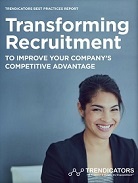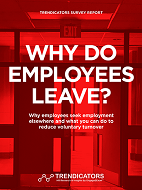
 Employee turnover is an even bigger topic in 2020, due to record low unemployment, than it was in 2018 when we produced the first edition of this report. Retaining employees has become one of the highest priorities for CEOs and HR leaders today. In many sectors, employee retention is now a critical factor in determining and maintaining a competitive advantage.
Employee turnover is an even bigger topic in 2020, due to record low unemployment, than it was in 2018 when we produced the first edition of this report. Retaining employees has become one of the highest priorities for CEOs and HR leaders today. In many sectors, employee retention is now a critical factor in determining and maintaining a competitive advantage.
Our latest Trendicators Survey Report, Why Do Employees Leave?, reveals that 46% of American workers are “seriously thinking about leaving their organizations within the next 12 months.”
In this report, you’ll discover:
- Top drivers that influence turnover intent
- Turnover-intention levels by generation
- The industry sectors at greatest risk
- Ideas for updating your retention strategy
Two years ago, when we first conducted our survey on why employees leave, unemployment was down, and the economy was improving. In that survey, we found significant gaps between employees who intended to stay and those who intended to leave.
Pay for Performance: When we asked employees if they felt their pay was directly related to how well they perform, 69% of those who intended to stay in 2018 answered favorably, compared with 37% of employees who were “seriously thinking about leaving within the next 12 months.” The level of dissatisfaction over pay dropped to 27% in our 2020 survey, indicating that perceptions of compensation levels have improved.
Generational Differences: Compared with 2018, we found two changes in turnover intention within generational groups. The percentage of Millennials thinking about leaving dropped from 58% in 2018 to 50% in 2020, while the percentage of Gen Xers thinking about leaving increased an equivalent amount, from 40% to 48% this year.
Sectors at Risk: The most significant and actionable finding in comparing differences in survey data over the last two years is a double-digit increase in turnover intention within five industry sectors, which you’ll read about on page 5. There, you’ll also discover five sectors where 50% or more of employees are seriously considering leaving within the next 12 months.
The Bigger Picture: Shrewd analysts know that reading between the lines of trends can reveal a bigger picture. On page 3, where we summarize the top drivers for turnover intention, you’ll learn about the four most significant drivers for turnover intention. After fair compensation, workers want to feel confident in their organization’s future and their own future at the organization. They want to believe they can achieve their career goals with managerial support. And they want exciting work, along with autonomy in completing that work.
The Big Takeaway:
In a nutshell, retaining employees in 2020 and beyond is all about the future. To build individuals’ confidence in their future with your organization, you’ll need to create more meaningful, relevant and achievable career experiences. Recommendations for helping managers and leaders accomplish these goals are provided in the last section of this report, beginning on page 6.
Enjoy the read!



